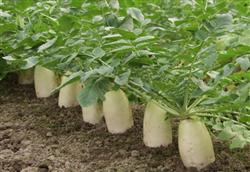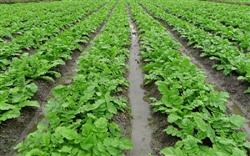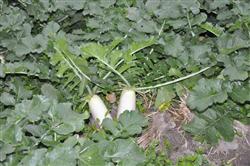How can summer radish be planted with high yield?

How can summer radish be planted with high yield? Please give guidance on the cultivation of summer radish should pay attention to the following aspects: the selection of excellent varieties. Because of the high temperature and heavy rain in summer, it is not conducive to the growth of radish, so the cultivated varieties must choose varieties with good heat tolerance, drought tolerance, strong resistance to diseases and insect pests and can form fleshy roots under high temperature conditions. There are Hot White, Xiao Goubai, Xia Changbai 2, Dongfang Huimei, Xiameinong Zaosheng 3, Xiakang 40 days and so on. Prepare the soil and fertilize. It is better to choose sandy loam with flat terrain, deep soil layer and good drainage and water conservation conditions. After the previous crop harvest, remove the residual branches and weeds in the field in time, and then apply fully mature ring fertilizer 4000 kg, potassium sulfate 15 kg, calcium superphosphate 30 kg every 667m2 for deep ploughing and soil preparation. After raking and leveling, ridging cultivation is carried out, the ridge distance is 80 cm, the ridge height is 15 cm 20 cm, each ridge is 2 rows, and the plant row spacing is 20 cm × 20 cm 25 cm. Sow seeds. ① seeding rate: the seed consumption of large type, medium type and small type were 0.5kg, 0.751kg and 1.52kg per 667m2, respectively. ② sowing time: the sowing time of summer radish can be sowed in batches from June to August according to the market demand. ③ sowing method: large varieties adopt hole sowing, hole depth 1.5cm-2.0cm, each hole put 2cm 3 seeds, after sowing, cover 2cm thick sifted fine soil; middle type varieties adopt hole sowing or strip sowing, trench depth is required 2cm 3cm; small type varieties can use sowing. Field management. ① timely seedling, fixed seedling: seedlings grow rapidly after they are unearthed, and seedlings should be carried out in time to ensure that the seedlings are neat and strong. The first seedling was carried out when the cotyledons were fully expanded, and the second seedling was carried out when there were 2 or 3 true leaves. When the seedling grows to 5-6 leaves and the fleshy root of radish breaks its belly, the seedling is fixed. ② intertillage, weeding and soil cultivation: combine intercropping seedlings for weeding, shallow first and then deep, so as to avoid root damage. Shallow ploughing can be done between the first and second seedlings, and the topsoil can be hoed; after the third seedling, a deep ploughing is carried out, and the soil in the furrow is cultivated on the border surface to prevent the seedling from falling. ③ watering: the temperature is high in summer and the soil water evaporates quickly. Watering should be timely and appropriate according to the soil moisture and the growth characteristics of radish. Germination period: watering according to the principle of "three water uniform seedlings", that is, watering once after sowing to facilitate seed germination; watering one water when planting bud arch soil to facilitate seedling emergence; watering again after finishing seedlings to benefit seedling growth. Seedling stage: because the root system of the seedling is shallow and the water demand is small, the seedling should be watered appropriately according to the principle of "less watering and frequent watering". Leaf growth and flourishing period: in this period, the leaf number of the upper plant of radish continues to increase, the leaf area increases gradually, the fleshy root also begins to expand, and the water demand increases rapidly, so it should be watered according to the principle of "proper amount and frequent watering". Fleshy root expansion period: this period has the largest water demand, should be watered frequently to keep the soil moist, so as not to cause fleshy root cracking caused by lack of water. ④ fertilization: when the fleshy root of radish seedlings is exposed to shoulder, 5kg of urea, 10kg of potassium sulfate and 3kg of superphosphate are applied with water to promote the expansion of fleshy root. At the beginning and peak stage of radish fleshy root expansion, 0.3% borax, 0.4% calcium chloride and 0.3% borax mixture, or 0.2% potassium dihydrogen phosphate and 0.3% borax mixture can be sprayed on the leaves to promote the expansion of radish fleshy root. Pest control. The summer temperature is high, there are many insect pests, mainly cabbage insects, aphids, Plutella xylostella, yellow striped beetle and so on. In addition to setting up black light and yellow board trapping in the field, at the initial stage of occurrence, the yellow striped beetle can be sprayed with BT EC 800000 times or 1000 times of trichlorfon wettable powder. To aphids, cabbage insects and Plutella xylostella, 48% Lesben emulsion 1000 times, 10% imidacloprid wettable powder 2500 times, and 5% Yitaibao EC 1000 times can be sprayed alternately once every 5 to 7 days. Harvest in time. The harvest time of summer radish is still in the high temperature period. After the fleshy root is completely expanded, it will be harvested and listed in time according to the market demand. Click for more radish planting techniques click to get more vegetable planting techniques
- Prev

How to irrigate summer radish?
How to irrigate summer radish? Please introduce the summer temperature is high, water evaporation fast, so according to the soil moisture and radish characteristics of the growth period reasonable watering. The seedling root system is shallow and the water requirement is small. It is necessary to master the principle of "less watering and frequent watering"; the leaf growth period is full, and it is necessary to master the principle of "proper watering".
- Next

What should we pay attention to when planting radish in summer?
What should we pay attention to when planting radish in summer? Please pay attention to the following aspects when planting radish in summer: using improved varieties: the selection of good varieties is a prerequisite for high quality and high yield of summer radish. Therefore, early-maturing radish varieties with good heat tolerance and strong stress resistance must be selected when cultivating radish in high temperature season in midsummer. ...
Related
- Where is it suitable to grow horseradish in China? it is expected to see the middle altitude horseradish in Alishan.
- How to prevent tomato virus disease reasonably? (Control methods included)
- Many people like to plant towel gourd on the balcony. What are the main points of this method and management?
- What crops can chili peppers be mixed with?
- Fertilization techniques and matters needing attention in Tomato
- What are the grafting techniques for peach seedlings in spring?
- Harm and control methods of root swelling disease of Chinese cabbage
- What are the pests of sweet potatoes? How to prevent and cure it?
- Symptoms, causes and Control methods of navel Rot in Tomato
- The cause of "Cucumber rotten bibcock" in Farmers' planting Cucumber and its Control Plan

